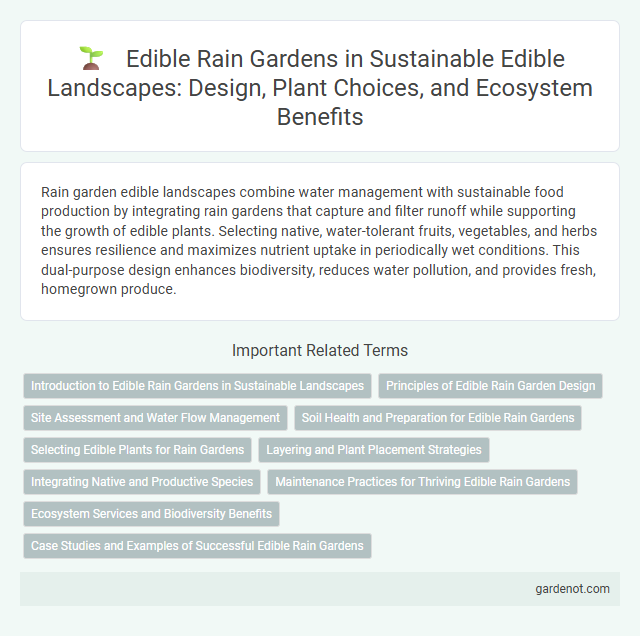Rain garden edible landscapes combine water management with sustainable food production by integrating rain gardens that capture and filter runoff while supporting the growth of edible plants. Selecting native, water-tolerant fruits, vegetables, and herbs ensures resilience and maximizes nutrient uptake in periodically wet conditions. This dual-purpose design enhances biodiversity, reduces water pollution, and provides fresh, homegrown produce.
Introduction to Edible Rain Gardens in Sustainable Landscapes
Rain gardens integrated with edible plants create sustainable landscapes by enhancing stormwater management while producing food. These gardens use native and drought-tolerant edible species such as herbs, berries, and vegetables to filter runoff, reduce erosion, and improve soil health. Implementing edible rain gardens supports biodiversity, conserves water, and offers a dual-purpose solution for urban and suburban environments.
Principles of Edible Rain Garden Design
Edible rain garden design integrates water management with food production by using native, drought-tolerant edible plants that thrive in both wet and dry conditions, improving soil health and reducing runoff. Strategic layering with deep-rooted perennials, shallow-rooted herbs, and ground covers enhances water absorption and nutrient cycling, promoting biodiversity and resilience. Proper placement and soil amendments ensure optimal drainage and moisture retention, supporting a sustainable, productive edible landscape.
Site Assessment and Water Flow Management
Site assessment for rain garden edible landscapes involves analyzing soil type, slope, and drainage patterns to ensure optimal water retention and plant health. Effective water flow management directs runoff into berms or swales, facilitating infiltration while preventing erosion and waterlogging. Incorporating native edible plants adapted to variable moisture conditions enhances ecosystem resilience and maximizes food production.
Soil Health and Preparation for Edible Rain Gardens
Soil health is crucial for successful edible rain gardens, requiring a well-draining, nutrient-rich medium that supports diverse plant growth and water infiltration. Preparation involves amending soil with organic matter like compost to enhance microbial activity, structure, and moisture retention, preventing erosion and nutrient runoff. Testing soil pH and texture ensures optimal conditions for edible plants while maximizing rainwater absorption and retention in the landscape.
Selecting Edible Plants for Rain Gardens
Selecting edible plants for rain gardens involves choosing species that thrive in wet conditions and help filter water efficiently. Ideal choices include water-tolerant herbs like mint and chives, leafy greens such as spinach and kale, and native berry bushes that attract pollinators. Incorporating deep-rooted perennials like horseradish enhances soil stability and nutrient uptake while providing sustainable harvests.
Layering and Plant Placement Strategies
Rain garden edible designs optimize layering by combining deep-rooted perennials with shallow-rooted herbs and groundcovers to maximize water absorption and nutrient uptake. Strategic plant placement prioritizes high-water-use plants in lower zones to capture runoff, while drought-tolerant species occupy elevated areas, enhancing garden resilience and productivity. Integrating diverse edible layers supports soil health, reduces erosion, and creates a sustainable micro-ecosystem for food production.
Integrating Native and Productive Species
Rain garden edible designs thrive by integrating native and productive species that enhance biodiversity and water management. Utilizing native plants like elderberry, cranberry, and serviceberry alongside edible perennials such as rhubarb and sorrel ensures resilience and abundant harvests. This strategy supports ecological balance while maximizing food production within sustainable rainwater harvesting systems.
Maintenance Practices for Thriving Edible Rain Gardens
Regularly monitoring soil moisture and ensuring proper drainage prevents waterlogging and root rot in edible rain gardens. Incorporating organic mulches conserves moisture, suppresses weeds, and enriches soil fertility, fostering healthy plant growth. Seasonal pruning and removal of spent foliage boost plant vigor and reduce pest and disease risks, maintaining a productive and sustainable edible rain garden.
Ecosystem Services and Biodiversity Benefits
Rain garden edible designs enhance ecosystem services by improving water filtration, reducing stormwater runoff, and promoting soil health. Integrating diverse edible plants attracts pollinators and beneficial insects, boosting biodiversity and sustaining local wildlife habitats. These multifunctional green spaces contribute to urban resilience by supporting nutrient cycling and microclimate regulation.
Case Studies and Examples of Successful Edible Rain Gardens
Edible rain gardens combine stormwater management with food production, exemplified by projects like the Seattle Food Forest, which integrates native plants and edible species to manage runoff while providing fresh produce. In Philadelphia, the Mill Creek Rain Garden successfully filters urban stormwater through a mix of edible perennials, demonstrating enhanced biodiversity and community engagement. These case studies highlight how edible rain gardens improve environmental sustainability and urban food security by utilizing rainwater for irrigating fruit-bearing plants and herbs.
Rain garden edible Infographic

 gardenot.com
gardenot.com